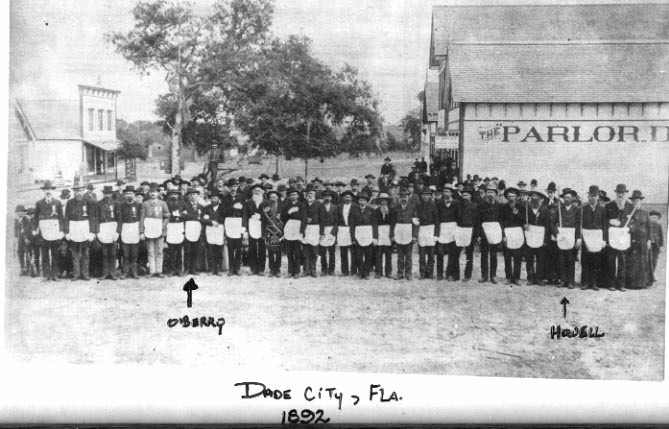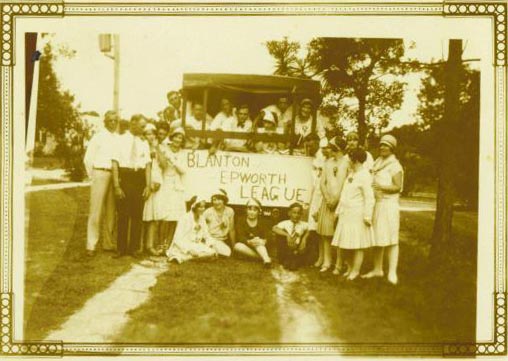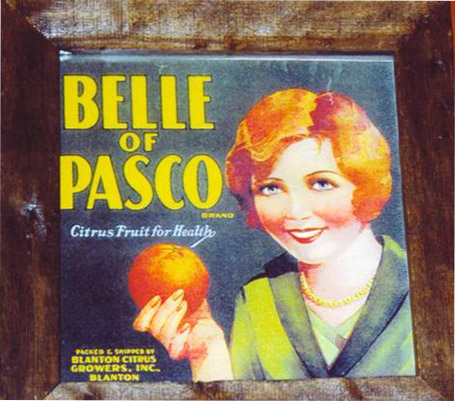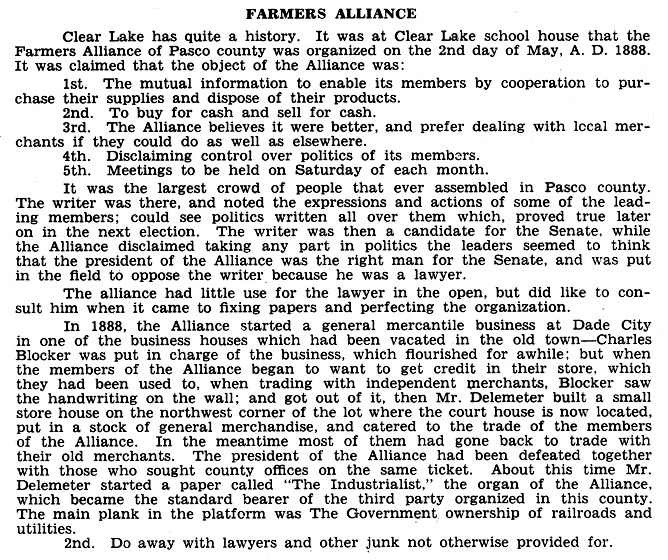HISTORY OF PASCO COUNTYBlantonOrganizationsThis page is taken, with permission, from the former My Blanton web site, created by Marinell Davis. Some photos from Lora Blocker. Masons This is the Howell of the Howell Grist Mill (today near south end of Hudson Road). His son, Jack Howell, opened the Chipco Mill. The Mason in the photo labeled Howell must be the son. (Too young to be the father.) O’Berry is John Marion Marion O’Berry of Blanton. His son, Solomon, was also a Mason for a while. Blanton Epworth League The Epworth League was founded on May 14th, 1889, in Cleveland, Ohio, to “help develop godliness and loyalty to God and Church among the young people.” It is a Methodist Episcopal (“High Methodist”) Church organization and was later replaced by Methodist YouthFellowship. Alongside Bible study, social service, and evangelism, these organizations sponsored co-ed social events for their high school-aged members. Leaders of these groups, however, asked for help in planning the social events. In response, denominational presses produced “fun books,” full of themes, games, and “stunts” for parties. While some of these parties had a Biblical or theological theme, most were strictly for fun. Farmers We don’t know if the early Grange was in Blanton, but some Blanton people were active in the Farmers’ Alliance beginning in 1888. Charles Blocker, a “Blanton man” and the brother of Frances Blocker, operated a general mercantile business for the Alliance in Dade City. (see below) On Feb. 18, 1920, the Farmers Club held their regular meeting here (Blanton) Friday night and transacted some important business. From packing labels, we know that, later, there were the Blanton Citrus Growers, Inc., and the Pasco County Peach Association. Other Blanton GroupsWere there Campfire Girls, Indian Guides, DeMolay, Eastern Star, 4-H, other farmers, church, and community groups in Blanton? We don’t know. You tell us!  FARMERS’ ALLIANCE Pasco County – 1889(Note: Macon, FL is just a few miles north of Blanton.) A Letter from the Land of Flowers, Fruit and Plenty Pasco County and The Farmers’ Alliance Macon, Florida [1889] This letter is from The Southern Mercury, Dallas, Texas, January 9, 1890. Professor Robert C. Cotner of the University of Texas called it to the attention of the Quarterly. EDITOR MERCURY: Believing that your readers would like to hear from South Florida, I will write a few lines. This part of the state is thinly settled. Pasco county has a population of 4,500, is on the western coast of South Florida, has good railroad facilities and the citizens will give you hearty welcome, if you wish to come to a country where there are no northers and the winter months are almost like spring time. The weather during December has been delightful, the thermometer ranging from 60 to 75 deg., during the day, and at night it falls to 50. The most disagreeable season is the rainy season in the summer. At this time of the year we have but little rain. The most of Pasco county is high, rolling pine lands, which produces fine vegetables, grapes, long staple cotton and fruit, if they are fertilized. The low lands are good for raising vegetables and oranges, when they are fertilized. The hammock lands will grow fine vegetables and fruits without fertilizing. Oranges is the staple crop of South Florida. In this part of the state we raise corn, potatoes, grapes, vegetables, (cabbage, tomatoes and beans are raised for market), tobacco, oranges, lemons, pine apples, bananas, limes, plums, peaches, (peaches don’t do well) and figs. There is money in an orange grove but you need not expect to get a good grove for the asking. They are high priced. It takes money and a great deal of hard labor, from six to ten years to get them to bearing, after which it is necessary for you to give them constant attention and fertilize them plentifully. Forty trees will do well on an acre and a tree will bear from 500 to 3,000 oranges. They bring on an average at the tree $1 per box, and a box holds from 96 to 300 oranges. Macon is a nice and pleasant town on the South Florida and O. B. [Orange Belt] railroad and one mile from where the F. S. [Florida Southern] and F. C. [Florida Central] railroad crosses. There is considerable excitement in this and other counties over the finding of phosphate beds. Men are here now buying lands wherever they can find phosphate. [The Farmers’ Alliance] The Alliance is coming to the front. It is a power in the land. Brethren, let us, like brave soldiers, come to the front and be true to the cause we are fighting for. Victory is ours, if we will only work as a unit. Brethren, read your state paper and the national organ; keep well posted. The Alliance is gaining strength here and all over the state. We have an Alliance store here and at San Antonio on the Orange Belt railroad. Both are doing a good business. Yours, J. F. MOODY. Southern Farmers’ AllianceDuring the 1870s, farmers in the West and South were afflicted by falling prices, mounting debt and climbing interest rates. A response to these conditions was found in 1877 with the creation of the Southern Farmers’ Alliance (formally the national Farmers’ Alliance and Industrial Union). The SFA grew when the Grange movement was declining as a force for reform. During the 1880s, the SFA claimed more than three million members, many of them involved in cotton production. Only whites were accepted for membership; the blacks would form a similar, but separate group. The primary concerns of the Southern Farmers’ alliance were twofold: 1. Purchasing Issues. Southern farmers attempted to band together to purchase equipment and supplies in bulk for price breaks. 2. Marketing Issues. Farm prices had been declining since the early 1870s, which provoked farmers’ increasing resentment of middlemen’s fees. Impetus grew to discover ways to bypass them. The Alliance addressed these concerns by fashioning cooperatives and trade agreements, efforts that improved the lot of some farmers. Tension developed over the question of affiliation with a political party. Some members believed that cooperative ventures were less beneficial than an expansion of the currency, creating support for the greenback movement and later the free silver cause. The Alliance proved to be incapable of confronting the farm overproduction issue. The Alliance supported the Populist Party in the Election of 1892, but declined rapidly in its aftermath. From: http://www.u-s-history.com/ |
